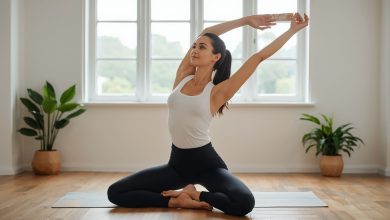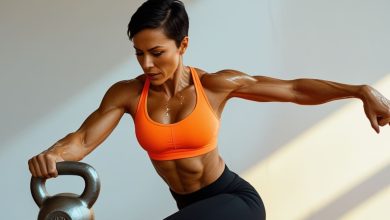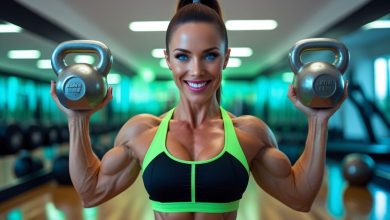
How to Build Muscle at Home doesn’t require a gym membership or fancy equipment. With High-Intensity Interval Training (HIIT), you can use your body weight and a structured workout routine to effectively build muscle, improve strength, and boost endurance. Whether you’re aiming to tone your body or increase your muscle mass, this guide will provide you with the essential tips, exercises, and strategies to build muscle at home.
What is HIIT and How Does it Help Build Muscle?
High-Intensity Interval Training (HIIT) involves performing short bursts of high-intensity exercises followed by a brief recovery period. The high-intensity efforts push your muscles to work harder in a short amount of time, promoting strength and muscle growth.
Why HIIT Works for Muscle Building:
- Muscle Engagement: The intensity of HIIT stimulates muscle fibers, especially when using bodyweight exercises. Each burst of activity challenges your muscles to work harder, leading to muscle growth over time.
- Caloric Burn and Recovery: While HIIT is often associated with fat loss, it also helps with muscle definition. Your body continues to burn calories long after the workout ends (known as the “afterburn effect” or EPOC – Excess Post-Exercise Oxygen Consumption), which can lead to fat loss and muscle toning.
- Flexibility: Since HIIT can be done with little to no equipment, it’s perfect for those training at home.
Best HIIT Exercises for Building Muscle at Home
These bodyweight exercises are ideal for building muscle, increasing endurance, and improving strength:
Push-ups
Push-ups target the chest, triceps, and shoulders. Start in a plank position with your hands slightly wider than shoulder-width apart. Lower your body until your chest nearly touches the floor, then push yourself back up. If regular push-ups are too difficult, start with knee push-ups or incline push-ups using a bench or sturdy surface.
Squats
Squats strengthen the quads, hamstrings, and glutes. Stand with feet shoulder-width apart, keeping your chest up. Push your hips back and lower your body as if sitting into a chair, keeping your knees behind your toes. Push through your heels to return to standing. To increase intensity, try jump squats, where you explode upward as you rise from the squat position.
Lunges
Lunges target the quads, glutes, and hamstrings. Step forward with one leg and lower your hips until both knees are bent at a 90-degree angle. Push off the front foot to return to standing. For added difficulty, do jump lunges (alternating legs) or Bulgarian split squats (with your back leg elevated).
Burpees
Burpees are a full-body exercise that increases your heart rate while targeting multiple muscle groups, including legs, chest, and arms. Start standing, squat down and place your hands on the floor, jump your feet back to a plank position, perform a push-up (optional), jump your feet back towards your hands, then explode upward into a jump.
Plank to Push-up
This dynamic movement engages the entire core while targeting the arms, chest, and shoulders. Start in a plank position on your forearms. Push up onto your hands one arm at a time, then lower yourself back down to your forearms, alternating arms.
How to Structure Your HIIT Workout for Muscle Growth
Building muscle at home with HIIT requires a structured approach. Start with a proper warm-up (5-10 minutes) using light cardio like jogging in place or jumping jacks, followed by dynamic stretches.
For the main workout, perform each exercise for 30-45 seconds at maximum intensity, followed by 15-30 seconds of rest. Rest is essential for muscle recovery and to keep the intensity high. You can structure your HIIT workout in a circuit style, performing each exercise consecutively with minimal rest between them. After completing one round, rest for 1-2 minutes and repeat for 3-5 rounds.
After the workout, ensure you cool down (5-10 minutes) with static stretching to improve flexibility and aid recovery.
Tips for Maximizing Muscle Growth with HIIT
One key aspect of building muscle is progressive overload, which means gradually increasing the intensity of your workouts over time. You can do this by adding more sets, increasing the duration of each exercise, or performing more challenging variations of the movements (e.g., jump squats instead of regular squats).
It’s also important to fuel your body properly for muscle growth. Protein is essential for muscle repair and growth. Aim to consume 1.2-2 grams of protein per kilogram of body weight daily, and ensure you’re eating a balanced diet with adequate carbohydrates and healthy fats for energy. Additionally, rest and recovery are crucial for muscle growth, so be sure to get 7-9 hours of sleep each night and allow at least 48 hours of recovery before targeting the same muscle group again.
While HIIT focuses on intensity, always prioritize form over speed to avoid injury. If necessary, slow down your movements to maintain proper form.
Sample HIIT Routine for Muscle Building
Here’s a sample 20-30 minute HIIT routine focused on building muscle:
- Warm-up: Jumping jacks (1 minute)
- Push-ups – 45 seconds
- Squats – 45 seconds
- Lunges (each leg) – 45 seconds
- Burpees – 45 seconds
- Plank to Push-up – 45 seconds
- Rest: 1-2 minutes
- Repeat 3-5 rounds
Conclusion
Building muscle at home is entirely possible with HIIT workouts, even without any equipment. By incorporating a variety of bodyweight exercises, focusing on intensity, progressively increasing your workout load, and allowing time for proper recovery, you can see significant improvements in muscle strength and endurance. Stick with a regular routine, fuel your body properly, and you’ll soon start noticing stronger muscles and improved overall fitness.



